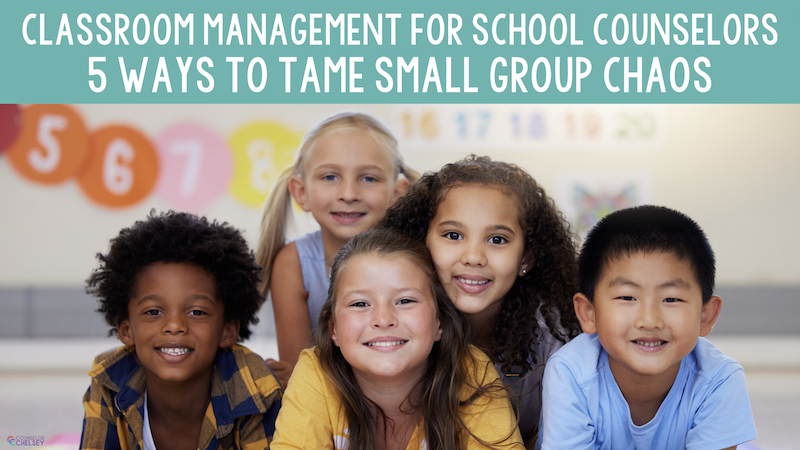Classroom Management For School Counselors: 5 Ways To Tame Small Group Chaos
Small group counseling lessons can be such a fun time for kids. It’s something different than their everyday routine, and they get to build relationships with kids they might not know well. However, for those exact same reasons, small groups can be challenging for the counselor leading them.
Many counselors haven’t been trained in classroom management, which can make it tricky to know how to minimize disruptive behaviors, support positive peer relationships, and still give engaging and effective lessons.
In this post, you’ll find classroom management strategies that will help you feel confident in your ability to reign in the chaos so that your small group counseling time can be as successful as possible.
Proactive Classroom Management Strategies
Classroom management isn’t just the things you do during the lessons. It also includes the way that you structure your small group, and the procedures you have in place that help your students understand and meet the expectations. Below are some things you can do before you start teaching the content to help your lessons run smoothly.
Limit The Number Of Students In The Group
I once made the mistake of having an anger management small group with 8 kids in it. That lasted one lesson… one long, terrible lesson. I immediately knew it wasn't going to work, and I split the group into smaller groups of 4.
This can be counterintuitive, because we want to maximize the number of students we reach. However, if we try to put too many kids in a group, it's harder for them to focus and learn the skills that we want them to learn.
For me, the number of students in the group depends on the age of the students and the topic. For behavior-focused groups, like those focused on anger management, self-control, following directions, etc., I feel like 4-5 students is the sweet spot. If you’re working with students in kindergarten or pre-k, you may want to have even fewer students.
If your small group is focusing on a topic like study skills, family changes, or grief and loss, you may be able to include a few more students, especially if they are older.
Unfortunately, there is no right number of students. It largely depends on the topic, age of the students, and even the personality of the counselor and the students. It may take you a while to figure out what the sweet spot is for you. My encouragement, however, is to start on the low end and to remind yourself that even if you only have 4 kids in the group, the time will be much more beneficial than if you had 10 students in the group.
Think About Seating
When we think about seating charts, we tend to envision classroom teachers using them for whole group instruction. However, intentional seating plans can be just as valuable in the small group setting.
The first thing to consider is what you will use for seating. For some people, this may be obvious - especially if you have a small table, rug, etc. that works well for small groups. One thing that is important, regardless of where your students are sitting, is for each child to have their own defined space. Chairs, sit spots, colored dots, etc. give students a visual reminder of where they are supposed to be in the room. When they can clearly see their space, it’s easier for them to stay in it.
Once you’ve figured that out, you can think about whether you will assign seats, or let students choose their own. There are pros and cons to both options. Letting students choose their own seats takes less time and effort, and is usually more enjoyable for the students. However, they may choose to sit somewhere that could distract them, and others, from learning. This is something that’s a personal preference - there is no right or wrong answer. Experiment with different things and see which strategy works best for you and your students!
Try This: If you are planning on sitting on the floor, write numbers on half sheets of paper (one for each student in the group), and tape them to the floor. Then, when the students enter the room, assign them a number to go to. The paper allows the student to visually see their space, and this process also gives you some control over who sits where.
Establishing Rules
An important part of classroom management is making sure that kids know exactly what they are expected to do (or not do!). This is especially true for small groups, since the rules & expectations are probably different than the ones they have in the classroom.
One way that I do this is by asking the kids to come up with their own expectations for themselves and other members of the group. At the beginning of the first session, I get out a piece of paper and we write down the things that the kids think would make an effective group. The kids usually have great ideas, and this allows them to feel invested in the success of the group. If the students are old enough to write their names, I have them sign the paper as a way to show that they agree to the expectations.
After the expectations have been written down, I keep the paper and display it during the rest of the group lessons. I also take a few minutes at the beginning of each lesson to quickly read through the expectations as a reminder.
Classroom Management During Group Time
There have been times that getting my group set up and having some proactive classroom management strategies in place have led to a super smooth group with few hiccups. BUT, there have also been times when I still ended up with kids rolling all over the floor screaming at each other.
While proactive classroom management strategies can certainly be helpful in setting you up for success, it is also important to have some tools you can use during your actual group time.
Point System
What It Is: This strategy is pretty straightforward - kids can earn points for positive behavior. Point-earning behaviors include following directions, working hard, treating each other with kindness, etc. I also award a point to the group if an individual student does something that goes above and beyond the expectations.
An important part of this system is that points can only be earned - not lost. However, there is one exception, which is asking about points. If kids ask how many points they have or ask if they will get a point for a certain behavior, etc., they lose a point. This is important because I don't want the point system to be a distraction from what we're doing.
I record the points on the board, and once the group earns a certain amount of points (I usually do 5 or 10), they earn a reward.
Some of my favorite rewards include:
A small piece of candy
A GoNoodle video
A quick game
Students choose where they sit
Why I Love It: It's a clear system that is easy for the kids to understand. Plus, it's so fun to see the kids encouraging each other to follow the group expectations.
Secret Student
What It Is: Secret student is a game that has been loved by many students. In it, the instructor chooses a student, but doesn't reveal who it is. If that student shows appropriate behavior, the secret student is revealed, and the group earns a point (see above) or a special privilege. If the student does not show appropriate behavior, nothing is earned, and the identity of the secret student isn't revealed.
I use this strategy a lot when walking in the hallway to and from my office. I usually pick up students from their classrooms and then drop them off after the group. “Secret Student” is a way to encourage positive hallway behavior during this somewhat unstructured time.
Why I Love It: I love it because kids love it. It's also a great way to help kids build confidence when they can contribute positively to the group. It also helps them to be accountable for their actions.
Small group counseling doesn’t have to feel chaotic. My hope is that these classroom management strategies will help your small groups be a positive learning experience for you and your students.









